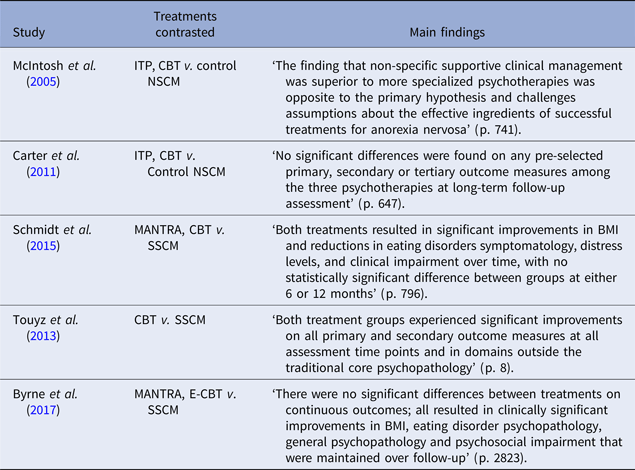Recently, Specialist Supportive Clinical Management (SSCM) has once again been found to be equally efficacious in comparison to the Maudsley model of anorexia nervosa treatment for adults (MANTRA) and an enhanced version of cognitive behavior therapy treatment (CBT-E), even though: ‘It was hypothesized that CBT-E and MANTRA would be superior to SSCM in terms of weight gain and eating disorder psychopathology as they both focus on specific maintaining processes’ (Byrne et al. Reference Byrne, Wade, Hay, Touyz, Fairburn and Treasure2017, p. 2824). It is interesting to stress that in this study the developers of the specialized brand-name treatments were involved in the design and monitoring of the study, which guaranteed that the appropriate version of the treatment was used in this randomized clinical trial.
It should be noted that SSCM treatment, originally a control treatment referred to as Non-specific Supportive Clinical Management (NSCM), was conceived as a placebo treatment in a randomized clinical trial to control non-specific aspects of two true psychosocial specialized treatments, cognitive behavior therapy and interpersonal psychotherapy. Contrary to the primary hypothesis of this study, both of the specialized psychotherapies were no more effective than non-specific supportive clinical management (McIntosh et al. Reference McIntosh, Jordan, Carter, Luty, McKenzie and Bulik2005).
It is difficult to justify that an originally non-specialized treatment works stubbornly as well as treatments that either target factors specific to the cognitive–interpersonal theory of the maintenance of AN (for example, in the MANTRA), or based on a broad transdiagnostic cognitive–behavioral theory of the processes maintaining eating disorder psychopathology (as in the case of the CBT-E).
As shown in Table 1, when specialized treatments, regardless of their specific components, are compared with the original NSSM, or the renamed SSCM, the pattern of equivalent outcomes is the norm. Furthermore, as it was acknowledged in the randomized clinical trial comparing the MANTRA with SSCM (Lose et al. Reference Lose, Davies, Renwick, Kenyon, Treasure and Schmidt2014) the authors declare: ‘The overlaps between MANTRA and SSCM remind us of the significance of the most basic features of any psychological treatment, such as regularity and predictability of appointments, being given time to talk, and above all the importance of a solid therapeutic relationship’ (p. 137). Thus, it appears we have been unable to develop a treatment capable of outperforming non-specific treatments for AN (Brockmeyer et al. Reference Brockmeyer, Friederich and Schmidt2017).
Table 1. Randomized clinical trials in anorexia nervosa in adults involving SSCM treatment

CBT, cognitive behavior therapy; E-CBT, enhanced cognitive behavior therapy; ITP, interpersonal psychotherapy; MANTRA, Maudsley model of anorexia nervosa treatment for adults; NSCM, Non-specific Supportive Clinical Management; SSCM, Specialist Supportive Clinical Management.
A critical appraisal with Occam's razor of this pattern of equivalences resulting from successive randomized clinical trials comparing specific against non-specific treatments leaves little doubt that the purported specific components of specialized treatments are largely superfluous once the effects of non-specific components common to any treatment are ruled out. Thus, if something helping is non-specific to the disorder, it would imply it is helping patients independently of the specific components of specialized treatments. In other words, brand-name specialized treatments probably do no more than provide a helping format stimulating the self-healing placebo response in humans (Gutierrez & Carrera, Reference Gutierrez and Carrera2014).
Two conclusions may be drawn from the above reasoning that: (a) the current theoretical convictions of researchers concerning the nature of the disturbed psychological processes in patients diagnosed with AN have missed the target, and more importantly; (b) we should critically revise core theoretical assumptions of AN as our current theoretical conception about its nature may be misguided (Gutiérrez & Carrera, Reference Gutiérrez and Carrera2016).
The future development of a treatment for AN should explore new routes as the current conceptualization of AN seem to be on the wrong track. Perhaps it would be wiser to refrain from refining current treatments, and contrary to common wisdom maybe the time has come to throw the baby out with the bathwater! To continue investing funds and time ignoring the message of past randomized controlled trials runs the risk of becoming a fruitless endeavor tantamount to flogging a dead horse.
Acknowledgements
Preparation of manuscript was supported by the research budget of the Unidad Venres Clinicos (University of Santiago de Compostela). The funding sources had no involvement either in the writing of the manuscript or in the decision to submit the paper for publication.
Authors’ contributions
OC and EG contributed equally to this work, and both authors read and approved the final manuscript.
Declaration of Interest
The authors declare that they have no conflict of interest.
Ethics approval and consent to participate
Not applicable.





